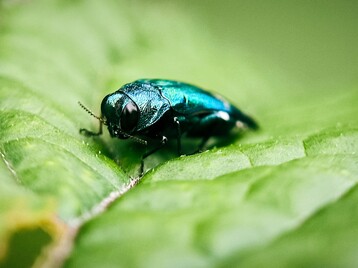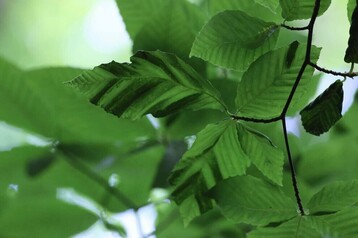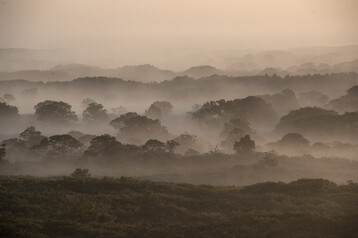Beware The New Pests Affecting Nantucket's Trees
JohnCarl McGrady •

Several new pests are affecting trees on Nantucket, breaching the relative safety offered by the island’s isolation.
“There are so many of these insects and diseases that are spreading,” Kelly Omand, a plant research ecologist and botanist at the Nantucket Conservation Foundation, said. “They are introduced by human activity.”
One of these pests is the emerald ash borer, a small, metallic-green beetle that feeds on ash trees. It is invasive to the region and has now spread throughout the state. Emerald ash borer is extremely new to Nantucket.
“This is the newest one we have discovered,” Bartlett Tree arborist Jim Cook said. “We discovered this on a town tree last week.”
Before that, Cook said, he wasn’t aware of any detections.
Emerald ash borer is highly destructive to ash trees and has proven challenging to control in North America. In 2023, the Massachusetts Forest Health Highlights report identified the emerald ash borer as the primary biological cause of forest damage in the state by a significant margin. It was responsible for 11,300 acres of damage. White pine needle damage, caused by fungus, came in second with less than 4,000 acres of damage.
If it is caught early enough, it can be treated with an injection. However, if too much of the tree is infected, the treatment becomes ineffective. Cook said that once 40 percent of the tree’s foliage has died, the treatment is far less likely to succeed.
There are no native ash trees on Nantucket, so the emerald ash borer is primarily a concern for homeowners, and not conservation groups.
Another of the new pests affecting Nantucket is hornbeam canker. Caused by the fungus Sphaerulina—unrelated to the similarly pronounced dietary supplement spirulina—the cankers affect hornbeam trees, often used in hedges on-island.
Cook said that there are currently no effective treatments available for the fungus, though existing fungicides can help in some cases.
“We have fungicides to help suppress hornbeam canker, but so far the results are not great,” he said. “We are working on a better treatment plan for this disease.”
There are also no native hornbeam trees on the island, meaning the problem mostly does not impact conservation groups.
Finally, there is beech leaf disease, first documented in the island’s forests at the Nantucket Conservation Foundation’s Squam Swamp property last July. While a case on a landscaping tree was identified years earlier, now that it has been identified in the island’s forests, it is spreading rapidly.

“It's already really colonized most of the northeast, so on Nantucket we expected, once we saw it last year, that it would spread really rapidly, and it has spread even more rapidly than we expected,” Omand said. “It just happens so rapidly. There's a very quick spread.”
Already, 82 percent of the beech tree stands surveyed on-island are infested.
For individual trees, there are effective treatments. Cook said there is a fungicide that can be injected into affected trees that is nearly always effective. While the fungicide is effective even after the more dramatic visual signs of the disease are noticed, Cook said it is better to treat early.
“Treat it when the leaves look good so that'll give you two full seasons of coverage,” he said.
But in forests, and at larger scales, those treatments aren’t feasible.
“If there were a treatment, it probably would really impact a lot of organisms in the forest...when you treat in a wild setting, it is particularly hard to keep the impacts just to that one organism,” Omand said. “We really can't do anything in a lot of our forest stands, both because of the scale and the pools. The wetland pools and the sensitive habitats.”

Omand said that the Nantucket Conservation Foundation has tried a fungicide in one stand.
“We're going to see what happens to the chemical, whether it's in the leaves that fall,” she said.
Without treatment, trees could start dying within a few years.
Beech leaf disease can be identified by dark stripes appearing on leaves, or heavily striped, shrunken, and crinkled leaves with a thickened, leathery texture. The disease is caused by tiny nematodes that infest the buds and leaves of a tree, thinning the canopy cover rapidly.
Responding to the new tree pests will require coordination between island conservation groups, the Town of Nantucket, and local homeowners.